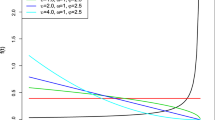Abstract
An important problem in reliability is to define and estimate the optimal burn-in time. For bathtub shaped failure-rate lifetime distributions, the optimal burn-in time is frequently defined as the point where the corresponding mean residual life function achieves its maximum. For this point, we construct an empirical estimator and develop the corresponding statistical inferential theory. Theoretical results are accompanied with simulation studies and applications to real data. Furthermore, we develop a statistical inferential theory for the difference between the minimum point of the corresponding failure rate function and the aforementioned maximum point of the mean residual life function. The difference measures the length of the time interval after the optimal burn-in time during which the failure rate function continues to decrease and thus the burn-in process can be stopped.
Similar content being viewed by others
References
M. V. Aarset, “How to identify a bathtub hazard rate,” IEEE Transactions on Reliability, vol. 36 pp. 106–108, 1987.
M. Bebbington, C. D. Lai, and R. Zitikis, “Operating hazard of a bathtub shaped failure distribution,” Submitted, 2006.
H. W. Block, and T. H. Savits, “Burn-in,” Statistical Science vol. 12 pp. 1–13, 1997.
H. W. Block, T. H. Savits, and H. Singh, “A criterion for burn-in that balances mean residual life and residual variance,” Operations Research vol. 50 pp. 290–296, 2002.
N. Ebrahimi,“On estimating change point in a mean residual life function,” Sankhyā Series A vol. 53 pp. 206–219, 1991.
R. C. Gupta, and O. H. Akman, “Mean residual life function for certain types of non-monotonic ageing,” Communications in Statistics—Stochastic Models vol. 11 pp. 219–225, 1995.
R. C. Gupta, O. Akman, and S. Lvin, “A study of Log-Logistic model in survival analysis,” Biometrical Journal vol. 41 pp. 431–443, 1999.
D. Kececioglu and F. Sun, Burn-in Testing: Its Quantification and Optimization, Prentice-Hall: Englewood Cliffs, New Jersey, 1997.
C. D. Lai, and M. Xie, Stochastic Ageing and Dependence for Reliability, Springer: New York, 2006.
C. D. Lai, M. Xie, and D. P. Murthy, “A modified Weibull distribution,”IEEE Transactions on Reliability vol. 52 pp. 33–37, 2003.
J. F. Lawless, Statistical Models and Methods for Lifetime Data, 2nd Edition, Wiley: Hoboken, New Jersey, 2003.
L. M. Leemis, and M. Beneke, “Burn-in models and methods: a review,” IIE Transactions vol. 22 pp. 172–180, 1990.
J. Mi, “Bathtub failure rate and upside-down bathtub mean residual life,” IEEE Transactions on Reliability vol. 44 pp. 388–391, 1995.
M. Mitra, and S. K. Basu, “Change point estimation in non-monotonic aging models,” Annals of the Institute of Statistical Mathematics vol. 47 pp. 483–491, 1995.
H. T. Nguyen, G. S. Rogers, and E. A. Walker, “Estimation in change-point hazard rate models,” Biometrika vol. 71 pp. 299–304, 1984
K. Tang, and J. Tang, “Design of screening procedures: a review,” Journal of Quality Technology vol. 26 pp. 209–226, 1994.
M. Xie, T. N. Goh, and Y. Tang, “On changing points of mean residual life and failure rate function for some generalized Weibull distributions,” Reliability Engineering and System Safety vol. 84 pp. 293–299, 2004.
Author information
Authors and Affiliations
Corresponding author
Rights and permissions
About this article
Cite this article
Bebbington, M., Lai, CD. & Zitikis, R. Optimum Burn-in Time for a Bathtub Shaped Failure Distribution. Methodol Comput Appl Probab 9, 1–20 (2007). https://doi.org/10.1007/s11009-006-9001-7
Received:
Accepted:
Published:
Issue Date:
DOI: https://doi.org/10.1007/s11009-006-9001-7




